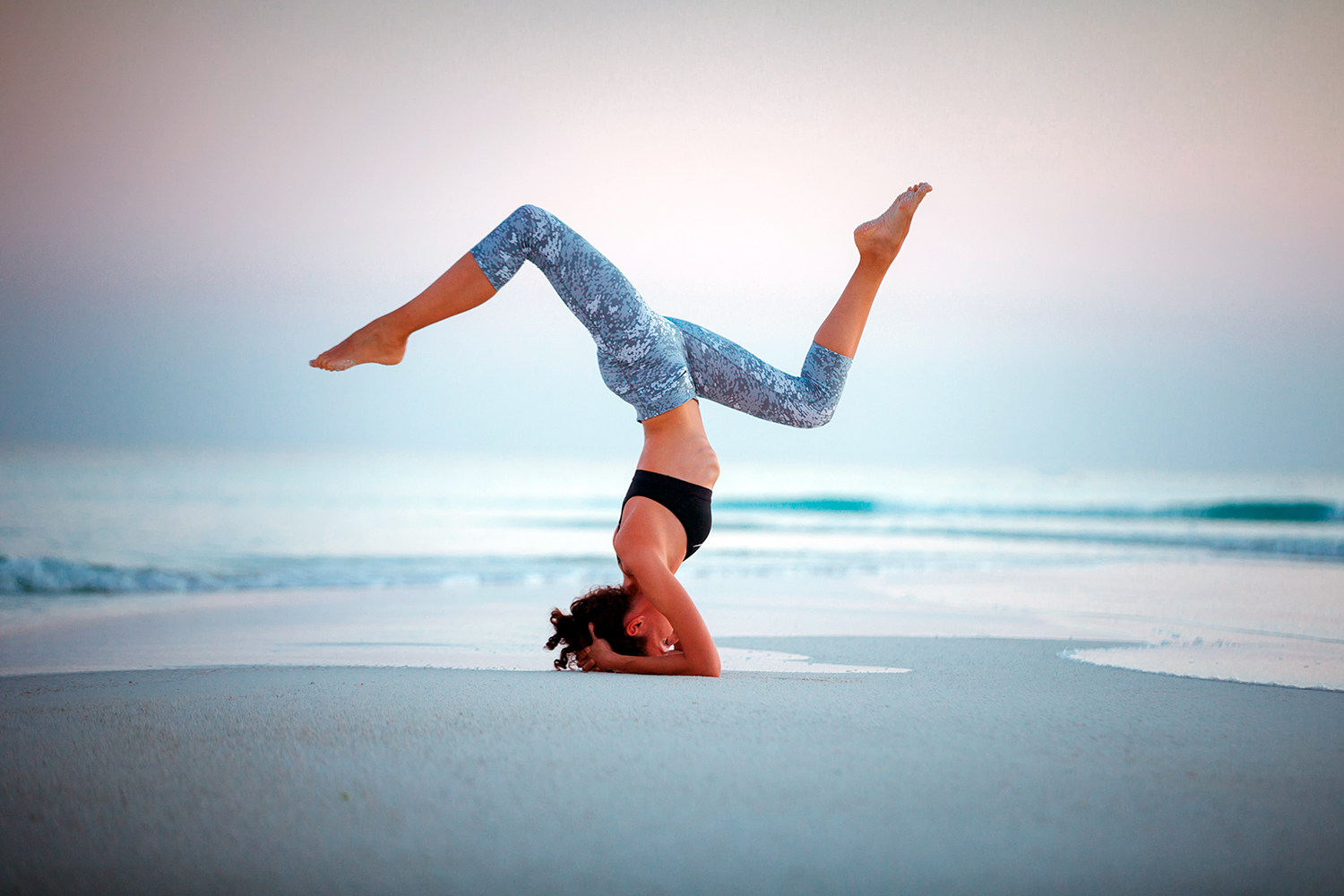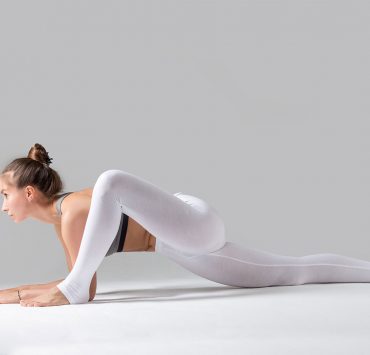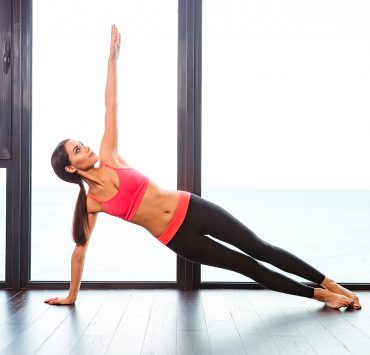
Having been a teacher’s assistant at over 50 yoga teacher…
Yoga is an incredible vehicle for witnessing changes in the body through mindful movement. These shifts occur in both beginner and advanced poses, but there’s something very significant in achieving a posture you never imagined possible. Pincha Mayurasana, also recognized as Forearm Balance or Feathered Peacock Pose, is a shape that many yogis strive to reach in their practice. It’s a delicate balance between surrender and control that’s only realized when we allow our trust to triumph over fear.
The elaborate name attached to this pose is warranted by the physical and mental strength it requires. Forearms are parallel on the ground with a 90-degree bend at the elbows and legs are straight up in the air. The core muscles support stability and create a straight line from feet to elbows. Finding this form will benefit the body by opening shoulders for back-bending, building arm muscle, and calming the mind.
Why Warm Up?
Before kicking straight into space, it’s essential to prepare the body for this new configuration. If mental awareness and physical strength are lacking, then the risk of injury goes way up. Start with other poses that flip your perspective upside down and get a feel for a shift in gaze. Building arm strength will increase your ability to enter, maintain and safely dismount a forearm balance. Explore poses that stimulate the power of your arms and find opportunities to add in extra challenges. Although the arms hugely support the body in this shape, don’t overlook the core muscles. They’re responsible for keeping balance and building proper alignment. Adding core exercises to traditional yoga postures is an easy way to activate this muscle group and form a solid base for your Pincha Mayurasana. Below are 15 useful poses and drills that will encourage your peacock to take flight.
Makara Adho Mukha Svanasana — Forearm Plank Pose

It’s unlikely that planks are your favorite, but they’re highly beneficial and strengthen all the muscles needed to balance on your forearms. Align the arms just as you would when entering Pincha Mayurasana, keeping elbows stacked under shoulders and fingers spread wide. Hug the belly up while rooting the tailbone down towards your heels to activate the core stabilizer muscles. The burn in your abs and arms may take your mind away from the lower body, but don’t forget to engage your legs. Try practicing this exercise daily and adding a little more hold time each week. Ignite that inner fire even further by adding in a sawing motion back and forth.
Paripurna Navasana — Boat Pose

Boat Pose, or Paripurna Navasana, is one of the most notorious postures for toning core muscles while strengthening the lower back. Start seated with knees bent and feet flat on the floor. Bring your arms straight out and begin to shift weight back until you find a balancing point on or behind the sit bones. Be sure to remain open in the chest and long in the spine as you lift your feet off the ground. Legs can go straight out into a full boat, or you may choose to modify with bent knees and shins parallel to the floor. For extra core and oblique love, add in some russian twists or straight-leg lifts.
Ardha Pincha Mayurasana — Dolphin Pose

You’ll have a tough time finding your way into a full forearm balance without first mastering dolphin pose. This shape is the first step to entering Pincha Mayurasana and indeed requires a great deal of strength and flexibility. Starting in downward facing dog, lower to your forearms, and walk your toes in towards your elbows. Keep the head and neck relaxed as you broaden across the shoulders to create space. This pose may be a bit awkward at first, but keep practicing, and it will start to feel more natural. Try slowly working up to holding it for more extended periods of time.
Shoulder Openers Pose

It’s no secret that the shoulder girdle needs to be strong to sustain a forearm stand, but there also needs to be an element of flexibility. Having open shoulders will aid in preventing injury while inducing some contentment amidst a challenging pose. There are many effective ways to relax and stretch the shoulders; the key is to find what jives with you and fully commit to that expression. A few wonderful postures include Thread the Needle, Puppy Pose, Cow-Face Arms, Eagle Arms, and Rabbit Pose. Remember to express patience with your body as you surrender into these vulnerable shapes.
Chest Openers

Feeling closed off or constricted across the chest can lead to severe strain when practicing forearm balances. It’s necessary to show this area attention for physical safety, but also to increase mental awareness and trust. Many poses will help you achieve different levels of openness through the heart. It’s wise to start small with gentle stretches, such as Sphynx or Cobra, then work up to more advanced poses, like Bow or Camel.
Purvottanasana — Reverse Plank Pose

In addition to lengthening the whole front line of the body, upward plank incorporates aspects of both chest and shoulder expansion. The front and back sides of the body are working hard to stabilize and create an active line of energy from head to toes. Start seated with legs extended, toes pointed, and hands planted several inches behind the hips with fingers facing toes. On an inhale, lift the pelvis and the gaze up by pressing into the hands and feet simultaneously. Hold for several breaths before mindfully lowering the hips back down. If this feels too intense to start, try upward table as a warm-up with knees bent. “Let go of your desire for outcomes and bring your awareness to the present moment. As you practice lifting your heart to the sky, you might discover that true power comes from within.”
Anjaneyasana — Low Lunge Pose

If you practice yoga regularly, then you’re likely very familiar with lunges. They’re a staple in many practices and provide a challenging combination of strength and flexibility. Low lunges are an excellent tool for examining and releasing any tightness in the hip flexors. A wide range of motion in this area is essential for entering and exiting Pincha Mayurasana comfortably. When holding your lunge, be sure to keep the front knee stacked over the ankle. Allow the inner thighs to draw together and notice a downward and forward movement of the pelvis.
Ardha Hanumanasana — Half Splits Pose

Low lunges present the perfect opportunity for transition into a half split. Simply begin to sink the hips back while straightening the front leg. You’ll notice lots of sensations in the calves and hamstrings, but try to keep a steady breath while absorbing the stretch. If you’re looking for more here, try entering a full split by extending the back leg straight out from the hip. Having flexibility in the legs will not only serve your lower back well, but it will also provide greater ease when accessing a forearm balance.
Standing Split Pose — Standing Splits Pose

One of the most significant aspects of Pincha Mayurasana lies in finding balance. Standing splits are excellent for challenging our sense of stability while lengthening and strengthening the legs in preparation for flight. From a standing forward fold, inhale up halfway with fingertips on the ground and exhale weight into your left foot. On the next inhale, extend the right leg out and up while internally rotating the thigh bone. Exhale and fold over your standing leg while bringing one or both hands to the grounded ankle. Try to focus on keeping the hips level rather than getting the lifted leg as high up as possible.
Makara Adho Mukha Svanasana — Dolphin Drills Pose

Once you begin to feel more comfortable in dolphin pose, start incorporating small exercises to prepare the body for liftoff. From your dolphin, slowly lift and lower one leg at a time while keeping the hips level. With one leg raised, attempt to take some small hops off the grounded foot. This action will become second nature once you’ve mastered a forearm balance, so it’s best to get the hang of it. One other exercise to practice from dolphin includes drawing each knee in towards the triceps while engaging the core and rounding the spine.
Salamba Sirsasana — Headstand Pose

Shifting your perspective and finding comfort while upside down is a significant part of understanding and performing any balancing posture. An inversion qualifies as any position that places the heart over the head, so downward dog could be a great place to start. If you’re ready to let your feet leave the floor, then start playing around with arm balances and maybe some more advanced inversions if you’re ready. Headstand is an excellent intro to forearm balances and serves a lot of the same muscle groups. Depending on how you’re most comfortable, several different arm placements are available for headstand. Whether you choose a tripod configuration with hands flat and elbows bent at a 90-degree angle, or the traditional approach with fingers interlaced behind the head, make sure your core and legs stay engaged. As you become inverted, make sure to keep the breathing calm and the gaze focused.
Bakasana — Crow Pose

Bakasana, or crow pose, serves as an attractive alternative when finding the courage to shift weight to the upper body. The posture comes with a wide variety of both mental and physical health benefits, including body awareness and total body strengthening. “It is the perfect balance of holding on and letting go. Crow Pose invites you to accept your fears and embrace the courage to fly.” Starting in a low yogi squat, place both hands down flat, with fingers spread wide. Rise high on the balls of the feet and shift your gaze and weight forward while beginning to hug the knees towards the triceps. Breathe in here and take the heels towards the sit bones. Don’t let the fear of face planting hold you back from venturing into this pose, trust yourself and remain aware of the strength you possess.
Viparita Karani — Forearm Balance On The Wall Pose

Alright, now it’s time to take your forearm balancing skills to the wall. This exercise will give you the confidence and strength needed to stand without any additional support. Find your way into dolphin pose with heels positioned at the base of the wall. One foot at a time, begin to walk up the wall until your feet are level with the hips. Elbows should be right under the shoulders and gaze between the hands. Root the forearms down to lift up and out of the shoulders while knitting the front ribs in to support the back body. If you’re feeling frisky here, you can play around with extending one leg at a time straight up, and perhaps that other foot floats off the wall for a fleeting moment.
Ardha Sirsasana — L-Shaped Forearm Balance Pose

As you start to feel comfortable with supporting the shape of a forearm balance at the wall, it’s time to take the metaphorical training wheels off. Taking your practice away from the wall may be intimidating at first, but move slow and trust your body to protect you when things become wobbly. Come to dolphin pose and tiptoe your feet in as close as possible. Inhale one leg up behind and gently hop off the other foot to find an L-shape with the legs. Don’t fret if this takes several tries, or if it doesn’t come right away. Hold patience and faith that the pose will become accessible when the body’s ready to support it.
Pincha Mayurasana With Props Pose

Here we are, at the full expression of Pincha Mayurasana. Now it’s time to fine-tune the posture and make some adjustments that will prevent future injury and adequately align the body. Props are excellent tools to help us explore poses in an accessible manner. To keep the arms from bowing out, try looping a yoga strap just above the elbows and have it tightened to shoulder distance. Another option is to place a block between the hands to prevent them from moving towards the midline. Props train good form and aid us in creating habits that will benefit the practice of all poses. “There is freedom waiting for you, On the breezes of the sky, And you ask “What if I fall?” Oh but my darling, What if you fly?”
What's Your Reaction?
Having been a teacher’s assistant at over 50 yoga teacher trainings worldwide, Rebecca Rebecca has a firm grasp on the fine art of yoga and meditation. In her work, she carefully reflects on a vast expanse of knowledge to help others find peace in both body and mind.














